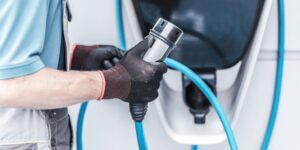How does a motorcycle charge its battery? Well, it’s a fascinating process that happens seamlessly behind the scenes. When you hop on your motorcycle and start the engine, a chain reaction is set in motion. As the engine roars to life, it spins a component called the alternator. This clever device functions as a miniature power plant, generating electricity as the engine turns. This electricity is then sent to the battery, where it is stored and used to power various electrical components such as the lights and ignition system. So, next time you take a ride on your two-wheeled companion, know that the answer to how a motorcycle charges its battery is a simple yet ingenious one.
How Does a Motorcycle Charge Its Battery?
If you own a motorcycle, you know that a well-functioning battery is crucial for starting the engine and powering the electrical components of your bike. But have you ever wondered how a motorcycle charges its battery? In this article, we will explore the various methods by which motorcycles charge their batteries and dive into the intricate details of the charging process. So, let’s get started!
The Charging System Components
Before delving into the charging process, it’s important to understand the key components involved in a motorcycle’s charging system. These components work together to generate electricity and charge the battery:
1. Stator: The stator is a stationary component located inside the engine case. It consists of a series of copper windings attached to the motorcycle’s alternator. When the engine is running, the stator generates electricity through electromagnetic induction.
2. Rotor: The rotor is a rotating component positioned inside the stator. It contains magnets that create a magnetic field when the engine is running. As the rotor spins, it induces an alternating current (AC) voltage in the stator windings.
3. Rectifier: The AC voltage produced by the stator needs to be converted to direct current (DC) for the battery to charge. The rectifier, also known as a regulator-rectifier, converts the AC voltage into DC voltage by rectifying the current.
4. Battery: The battery stores electrical energy for starting the motorcycle and powering electrical components when the engine is not running. It gets charged by the motorcycle’s charging system.
The Charging Process
Now that we’re familiar with the key components, let’s explore how a motorcycle charges its battery. The charging process can be broken down into the following steps:
1. Cranking the Engine: When you start your motorcycle, the battery supplies power to the starter motor, which turns the engine’s crankshaft. As the engine begins to rotate, the stator starts generating electricity.
2. Generating AC Voltage: The rotating magnets in the rotor create a changing magnetic field, which induces an alternating current (AC) voltage in the stator windings. This AC voltage has a fluctuating waveform, similar to a sine wave.
3. Converting AC to DC: The AC voltage generated by the stator needs to be converted to direct current (DC) to charge the battery. The rectifier, connected to the stator windings, rectifies the AC voltage, converting it into DC voltage.
4. Regulating Voltage: The rectified DC voltage is then regulated to a consistent level to prevent overcharging or undercharging the battery. The regulator component of the rectifier-regulator system ensures that the voltage supplied to the battery remains within the optimal range.
5. Charging the Battery: The regulated DC voltage is now sent to the battery for charging. The battery’s internal chemical reactions reverse during charging, allowing it to store electrical energy for later use.
6. Powering the Electrical Components: As the engine runs, the charging system not only charges the battery but also supplies power for operating the motorcycle’s electrical components, such as lights, horn, and ignition system.
7. Maintaining Battery Charge: The charging system continuously monitors the battery’s charge level. If the battery voltage drops below a certain threshold, the charging system increases the output to maintain an optimal charge.
Different Charging Systems
Not all motorcycles have the same charging system setup. Let’s explore the two most common types of charging systems:
1. Permanent Magnet System: Some motorcycles use a permanent magnet charging system, where the magnets on the rotor are always magnetized. These magnets generate a magnetic field that induces the AC voltage in the stator windings as the engine runs. The AC voltage is then rectified and regulated before charging the battery.
2. Field Coil System: In a field coil charging system, the rotor contains a field coil instead of permanent magnets. When the engine starts, the field coil is energized by the battery or a separate power source, creating a magnetic field. This magnetic field induces the AC voltage in the stator windings, which is subsequently rectified and regulated to charge the battery.
Maintaining a Healthy Battery
To ensure a healthy battery and optimal charging, here are a few tips:
1. Regular Maintenance: Check your motorcycle’s charging system regularly for any signs of wear or damage. Inspect the battery terminals for cleanliness and tightness.
2. Keep the Battery Clean: Clean the battery terminals regularly to prevent corrosion, which can impede the charging process. Use a mixture of baking soda and water to clean the terminals and a wire brush for stubborn corrosion.
3. Avoid Deep Discharges: Try to avoid fully discharging your battery frequently, as it can reduce its overall lifespan. If your motorcycle has been sitting idle for an extended period, consider using a battery maintainer or trickle charger to keep the battery charged.
4. Optimal Riding: Regularly taking your motorcycle out for a ride ensures that the battery receives a proper charge. Extended periods of inactivity can lead to battery drain and reduced performance.
5. Replacement when Needed: If your battery is consistently failing to hold a charge, it may be time for a replacement. Consult your motorcycle’s manual or a trusted mechanic for guidance on selecting the right battery for your bike.
Understanding how a motorcycle charges its battery is essential knowledge for any motorcycle enthusiast. The charging system’s components work together to generate electricity, convert it from AC to DC, and regulate the voltage to charge the battery while powering the motorcycle’s electrical components. By following regular maintenance practices and taking care of your battery, you can ensure a smooth ride and avoid any unexpected hiccups on the road.
Frequently Asked Questions
How does a motorcycle charge its battery?
A motorcycle charges its battery through a process called the charging system. The charging system is composed of several key components that work together to generate electricity and recharge the battery while the engine is running.
What are the components of a motorcycle’s charging system?
The main components of a motorcycle’s charging system are the stator, rotor, rectifier/regulator, and battery. The stator is a stationary part of the system that produces alternating current (AC) as the engine runs. The rotor, also known as the flywheel, spins around the stator and generates a rotating magnetic field. The rectifier/regulator converts the AC from the stator into direct current (DC) and regulates the voltage to prevent overcharging. The battery stores the DC electricity for later use.
How does the charging system work?
As the engine runs, the rotor spins around the stator, creating a magnetic field. This magnetic field induces an AC current in the stator windings. The AC current is then converted into DC by the rectifier/regulator, which also ensures that the voltage remains within the appropriate range. The DC electricity is then directed to the battery, where it is stored for future use.
Does a motorcycle charge its battery while idling?
Yes, a motorcycle can charge its battery while idling, although the charging rate may be slower compared to when the engine is running at higher RPMs. The charging system operates as long as the engine is running, providing electricity to power the motorcycle’s electrical components and recharge the battery.
What happens if a motorcycle’s charging system fails?
If a motorcycle’s charging system fails, the battery will not receive a continuous supply of electricity and will eventually drain. As a result, the motorcycle’s electrical components will stop working, and the engine may eventually stall. It is important to address any charging system issues promptly to avoid being stranded due to a dead battery.
Final Thoughts
A motorcycle charges its battery through a generator, also known as an alternator, which is connected to the engine. As the engine runs, it turns a rotor inside the generator, producing an alternating current. This current is then converted to direct current by a rectifier, which charges the battery. The charging process continues while the engine is running, ensuring that the battery remains fully charged. So, how does a motorcycle charge its battery? Through the power generated by the engine and converted by the alternator, providing a continuous supply of electrical energy to keep the battery charged.



